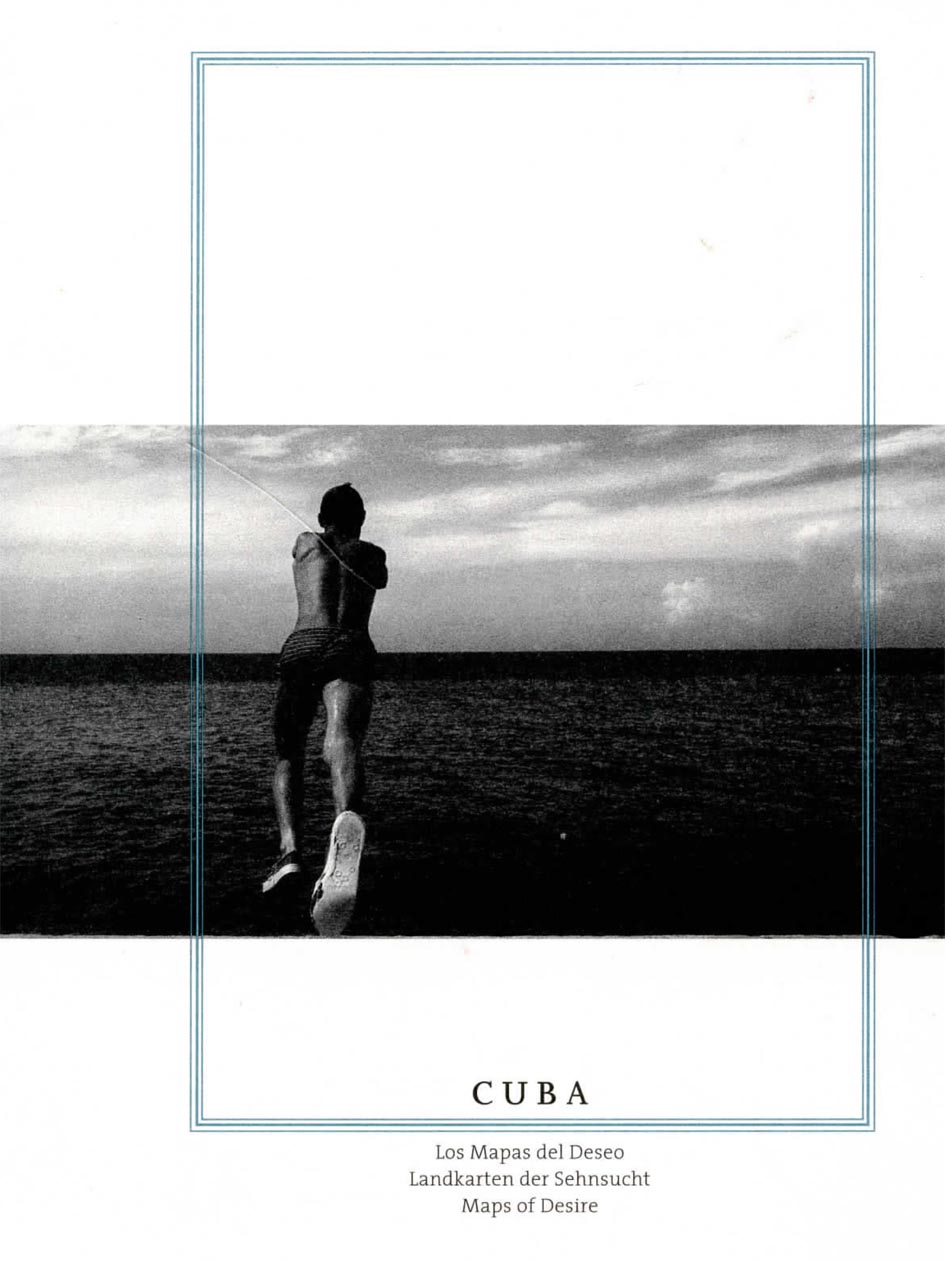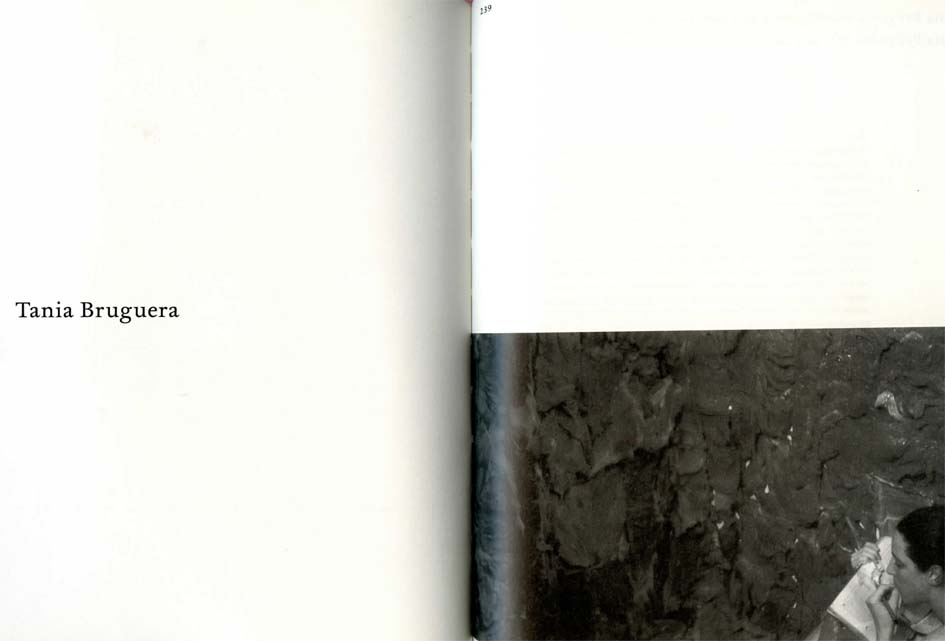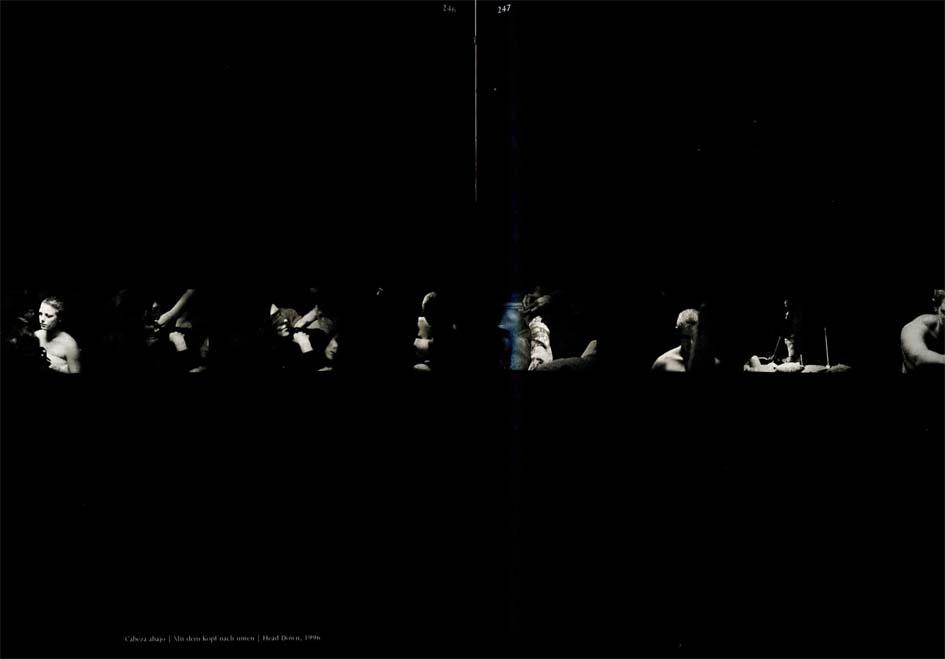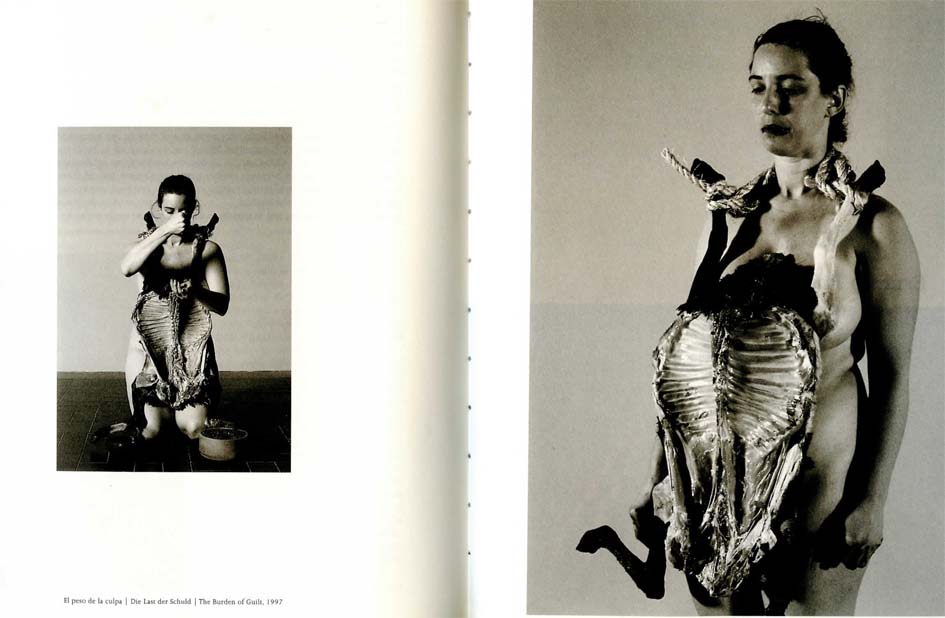with Octavio Zaya
September 1999
From: Zaya, Octavio. “Cuba: los mapas del deseo,” Ed. Kunsthalle Wien, Austria, 1999 (illust.) pp. 239 – 257.
ISBN 9-783852-561103
Tania Bruguera in conversation
with Octavio Zaya
What work will you be showing in Vienna?
In this exhibition, I’ll be presenting Estadística (Statistics) and El Peso de la Culpa (The Burden of Guilt)
Can you tell us a little bit about these pieces?
Estadística came about in 1992, when I was involved with the series Memoria de la Postguerra (Memory of the Postwar). In that series I tried to create work that functioned as testimony as well as social commentary, focusing primarily on the relationship between art and power. At the time, I was trying to salvage the themes and icons used by the 80s Generation* in Cuba and to analyze what had happened. That generation had just emigrated, if not its entirety at least a majority. What we were left with looked like a landscape of trenches devastated by war, in which many of us who remained were exhausted, beaten or disillusioned and changed our outlook or picked ourselves up in a more personal, private way. It seemed to be very much what I’d heard described as a postwar situation, except that in this case it had been a war of ideas. At least that was my way of seeing things, and the work that I’ve been doing since has to do with rescuing a lot of what has been lost in the social process which we are experiencing. For me, Cuba has always been a place where personal issues play out collectively. Every gesture is a political act. The educational system is the same for everyone. Social plans involve everybody and cannot be ignored. Our lives are very similar and, to top it off, social responsibility is considered a duty, practically an acknowledgment of our personal gratitude. Perhaps other generations in my country have a different vision but this, at least, is the experience with which I grew up. That is, perhaps, why the work that I’ve created serves as a bridge between historical elements, as a witness to the moment we’re experiencing in Cuba, and as my own way of resolving the conflicts that these things brings up on a personal level. Estadistica, for example, is a funeral flag, which began as a mark on the wall, as an almost obsessive way to keep track of an indefinite time, using clumps of human hair gathered from anonymous Cubans, rolled and tied with string. For me, each clump of hair symbolized a day, a person. Later, while trying to make a more direct reference to Cuba, I decided to use the image of the flag. It’s made with a black background. I wanted to suggest the flags, which are flown outside homes that are in mourning. The hair is tied with red, white and olive-green string, which are a substitute for the real colors of the flag. I used hair because it’s an element in Cuba, as in many other cultures, which is considered to hold energy, a person’s willpower. That’s why in the Afro-Cuban religion it’s one of the parts of the living body most often used to control somebody’s mind thoughts, decisions. The idea of trying it up with string is quite literal. This piece has a ritualistic element, from the moment of gathering the hair, rolling it up, sitting down everyday –which we did for months- to sew the Cuban flag as if we were back in the colonial times. At the time, the women of the house would get together to sew this same flag, which at that time was not the national emblem but a symbol of revolutionary ideas and the struggle for independence. It was an act of conspiracy and solidarity. It was a way of being useful outside the field of war. These flags were sewn onto uniforms, handkerchiefs, or served as war banners. I decided to approach the process the same way, so that during the four months that we were making this piece, every time friends came to the house, we would give them a needle, explain what we were doing, what hat to be done, and they would then become a part of the work.
And El Peso de la Culpa?
El Peso de la Culpa is also a part of the series Memoria de la Postguerra. This piece, which is a 1997 performance, distances itself somewhat from my prior work,; I think it’s a turning point in my art. In this piece I take on issues of guilt and responsibility in a conscious way for the first time. These elements, together and in relation to the issue of silence, constitute a new focus in my most recent efforts. In this piece I specifically refer to the collective suicides of the indigenous Cuban people during the Spanish occupation. The only way that some of them could rebel – as they didn’t have any weapons and they weren’t warriors by nature – was to eat dirt until they died. This gesture, which has remained with us more as a historical rumor, struck me as hugely poetic. In a way, it speaks to our individuality both as a nation and as individuals. Eating earth, which is sacred and a symbol of permanence, is like swallowing one’s own traditions, one’s own heritage, it’s like erasing oneself. It’s electing suicide. What I did was take this historical anecdote and update it to the present. This acts in combination with the fact that in Cuba, when one is said to be “eating dirt” in the popular sense, it’s understood that one is going through a very difficult time. The performance manifests as a solemn ritual which also involves salt water, which engages with the earth as a symbol of tears, and a headless lamb hung from my neck which functions as a protective shield which, in turn, because of its weight, functions as a symbol of submission. It’s a work in which the idea of punishment (in this case, self-punishment by “suicide” and the “erasing” of oneself) converges with the causes of guilt (submission, passivity). The first materializes in the act of eating the dirt, the second in the image of the lamb hung around my neck. The punishment is for being submissive, but that passivity is also a way to survive, and that kind of salvation is a slow death.
You presented this performance during the Fifth Havana Biennial and the flag was one of the elements you included in your participation in the Second Johannesburg Biennial, right? Considering the versatility of these pieces, and particularly your manner of presentation, what is the relationship between your performative work and your objects and other visual pieces?
I came to performance through installation. I was looking for a less passive way to engage with the audience, a way in which they would also feel involved. At the time (I was still at school then). I was very attracted to the idea of art as something ephemeral; as an experience, as something one lived through as much as an agent for social change. In that exploration, I felt a need to combine different media, to find another way to express myself. I like installation very much because it gives me a different media, to find another way to express myself. I like installation very much because it gives me a great deal of creative freedom, and I still use this medium, but it got to a point where I found it a bit academic and performance seemed like a more radical step, more open, with more possibilities and resources for expression. Not only did performance provide a more intense experience for me in the creation of the work, but I think it was also a way of sharing with the audience with greater access and participation on their part. In fact, it seem to me that the audience has an even greater opportunity to take in the message because, among other things, we are thinking through the same situation. When I began to perform, I thought I’d found the medium with the solution to all my restlessness. It struck me as an ideal medium, ephemeral but with great impact. I think my performances have the same creative weight as my objects and other pieces. I don’t make a distinction between my performative and object and visual work; each one is an extension of the other and they influence each other. They are the same thing – a moment of reflection, of doubt, of pain, which seeks to express itself. Sometimes the performances have been directly related to other work I’ve created, in some cases becoming a part of an installation or accompanying pieces that otherwise work independently. At other times the performances have existed in their own universe. In the end, the work is remembered as images in our memory, impressions, and also as stories. The work functions as commentary. As such, I think performance can work like any other medium. Art is a way that some of us have learned in order to get to other things, a way of relating to them. Some of us make art not just because it’s the language in which we’ve learned to express what we feel and think but because it is also how we’ve learned to act upon certain things.
You talk about engaging with the audience, about art as an agent of social change, about access, participation… and yet the work is always somewhat hermetic, poetic and unresolved, as if it’s always in process.
It’s truethat in my work there is an awareness of the ephemeral, of how certain events generate ways of thinking that may be temporal. This, more than the materials I use, is reflected in the way I approach my themes, with the understanding that my opinion is testimony about a moment, a point of view. Rather than offering conclusions, I’m interested in having my work provide one of any possible approximations to the specific process of change that we’re experiencing in Cuba, and which I am a part of. I do this through my own questions, from the position of a human being who is affected by all this change and instability, who is made to think, to question, to analyze her fears, her permanence, her identity, her guilt, her punishment, her actions, among a thousand other things. With luck, the specificity of my experience reflects something to do with our won insularity, with our won solitary sense in terms of politics, or with the eternal self-conscious monologue, which is such a part of our culture in Cuba (though there are Cubans dispersed all over the planet). As of this moment, my experience has been that whenever Cubans see my work, no matter where they are, they understand what it’s about perfectly, or what they’re participating in. Those people who are not conversant with the situation in Cuba may not get all the clues, but they leave with a desire to know more or, at the very least, with a certain emotional connection. Whenever possible, I also like to show my work in circumstances in which the people present ay not necessarily know about art, as is the case in my neighborhood, Old Havana, which is the colonial district and a very unpretentious and chaotic place. For example, the first time I presented El Peso de la Culpa was in my home studio in Havana, and it worked very differently than when I did it the second time in Venezuela. In Havana my neighbors were mixed into the crowd with artists and curators who had come for the Fifth Havana Biennial. Cuban artists and the people from my neighborhood enjoyed the piece very much. For them, it came out of an everyday and familiar experience. What foreigners saw in this case was a very dramatic image, accompanied by a gesture which, at first glance, may have seemed very common, but which became something dangerous and alarming. In Venezuela, this performance functioned as a very intense and risky image. To be honest, I’m not interested in having everyone decipher and understand every single detail, but neither is my objective that the work be hermetic. This is simply how the work emerges, with the cultural accumulation that takes place inside me, and which can e quite extensive. But often what happens is that the work is hermetic, or not understood by the majority of the audience, which may not be familiar with art, and they need a certain guidance. It’s certainly happened to me when I’ve seen performances or pieces trying to make connections with things I know, even though I may not have the whole story and perhaps there may be things I lack. But I think that’s the moment of reaction in which people make associations with what they know – the body, the feminine, women, and all these other things which may not have any relationship to what I’m trying to say. In the end, it’s all legitimate, because when we look at the work by Swiss or Asian, or even North American artists reproduced in art magazines, we don’t all understand everything. In some cases, to really understand the artist’s intention, we need a little more information or exposure, and so the work becomes somewhat hermetic, but this doesn’t diminish its impact or courage.
In the context of the dialectic between the work and its environment, what is the relationship between the poetic and the political in your work?
While I was staying in Chicago, I went to a very emotional concert by the rock singer Patti Smith in which she recited the U.S. Declaration of Independence as if it were a poem. When she began, I didn’t recognize what she was reading. It was simply a beautiful exhortation on the hopes of humanity, equality, and the right people have to govern themselves. When I finally realized what it was, it shocked me a little until I remembered that Ho Chi Minh had also quote from the same document in order to justify freedom for Vietnam. The intention matters a great deal. Just remember that Jose Martí is quoted by Cubans everywhere, with different and often opposing intentions, to justify their political positions. But none of that ultimately diminishes the poetic force of his writing.
On the one hand, your work is closely related to religious activity in that it has a participatory component; on the other, it’s always an intimate expression and often autobiographical. Could you talk to us about those two aspects (religious and personal experience) and how they relate and function in your work?
I think more than religious activity, what my work approaches is the spiritual and mystical. To talk about religion to a certain extent, for me, is to talk about institutions, what is regulated and what one must comply with. To talk, about spirituality, for me, is to talk about what’s inside of us and what makes us sensitive beings. The mystical, for me, is the ethical relationship we have with “something” (which everyone defines in an individual way) which has certain aims, almost always impossible to attain (therefore, almost always idealized) that result in a just and noble way of being. For me, mysticism provides a certain free space… it’s the journey. I think that if you live in Cuba, it’s almost impossible not to have a mystical moment. Mystical elements are organically integrated, or are the causes of conflict, but they aren’t alien. There are countless manifestations in everyday life: from commonly used refrains to superstitions, to figures such as Che Guevara and how religions manage to graft certain meanings onto a particular figure, I don’t do it in an illustrative or didactic manner, but rather because I think it is an element that will bring an experience closer to those who are living it, or because I find the way a concept has been condensed into that metaphor or image fantastic. The lamb, salt, water, nails – all those elements have a symbolic weight well beyond any one religion, they’re part of a universal iconographic vocabulary. I do think I use a system of repetition, however, one that is a obsessive, cathartic, which someone once suggested to me seemed like the litany of prayer repeated over and over.
Could we say that your work may be seen as a ritualistic activity? And in this sense, is this what brought you so close to Ana Mendieta? Could you discuss at length what the appropriation of her work means in you work, what it implies – to conclude – in the continuity of yours?
The tribute I made to Ana Mendieta was my graduate thesis at the Instituto Superior de Arte in Havana. I was drawn to her because of the force of he imagery and also because of my interest in the Cuban cultural context, where for me she symbolized a process of understanding with those who’d emigrated from Cuba, a process I was in the process of living. As someone who lived in Cuba, for me she became the evidence of a part of ourselves that we did not know, but which did exist. That piece was a cultural act. The object was the point of reference. I was merely the archeologist, the medium. Ritual, which was part of her work, was the way in which I approached her. The idea was to incorporate her, to rescue her from oblivion, to make her a par of the cultural context. It was to give her a space and a time in Cuba. And what better way to do that than through her won work? It’s been a long time since I finished that series of tributes to Ana. I think her place in Cuban art history is assured and, in any case, her work is now handled by a first class gallery engaged in a campaign of awareness and promotion which it well deserves. I think, though, that rather than about a continuity, it makes more sense to talk about an intersection between our work. Ana was interested in recuing the idea of Cuba from the outside; I was interested in resuming the idea of the Cuba was abroad. Now that I’ve had an opportunity to spend time away from Cuban and then come back, as I always come back, my work has begun to focus more on issues such as responsibility, guilt and silence. For me, in the work about Ana as in all my pieces, ritual is more of a means than an end. We were talking about religion before, and about ritual as an element that I’ve always been drawn to. I’m fascinated by how each faith creates rituals out of its myths, and how many of these coincide in their purpose or in their manifestations. In a way, religions offer practical parameters (through ethics or fear of punishment) so that we can live in a society; ritual is, for me, the journey from religion to mysticism. Also, I grew up in a society where the ideological and the mystical are combined. I live within a revolution that has always been very conscious of how to use metaphor and the force of ritual in its activities. We all had to stand up as students everyday to say. “ We will like Che!” We all used to kerchiefs that symbolized a million things and which became a terribly important element; indeed, there is a whole process (very ritualistic) in which you go from one level to the other and change the color of your kerchief. In y opinion, ritual is the basis for stability in every society and, as a result, an element that also works within art.
Translated for the website by Jimena Codina



